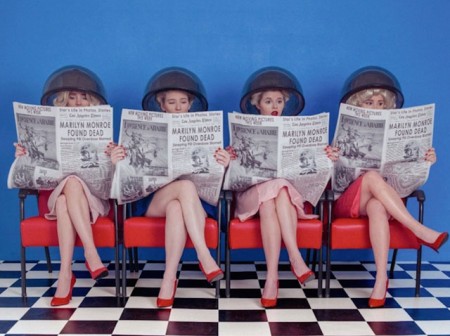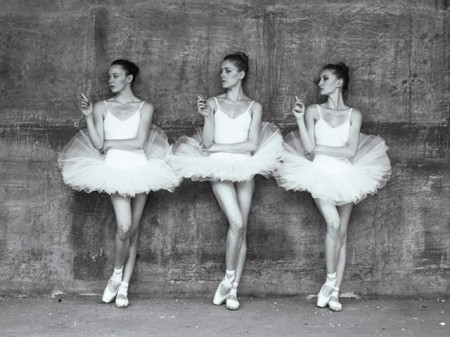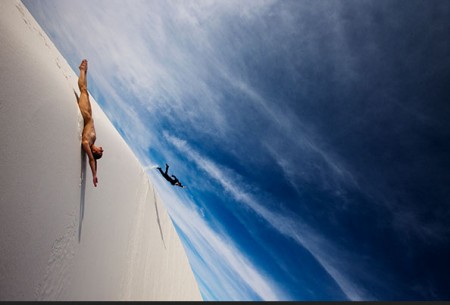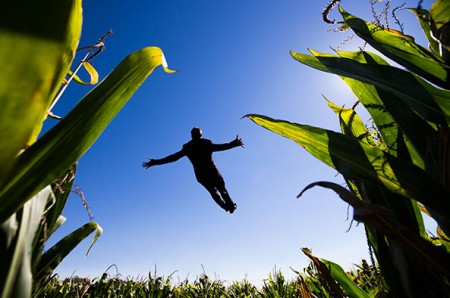Provocateur, Tyler Shields’ new book of photographs, is a weighty publication. Close to a square foot in shape and about an inch and a half thick, it comes in at between six and seven pounds on my kitchen scale. So – best looked at opened on a table.
Shields sets out to surprise and engage his viewers and is at home in color and black and white. The large scale pages are handy as he prefers not to be confined to standard 8×10 proportions. When he wants to, he stretches a horizontal across two pages, with generous white space above and below. The occasional square photograph turns up. He has a good eye and seems to enjoy his field.
These are not slice-of-life photographs. The people in them frequently wear no clothes, they sometimes (clothed) are jumping in astounding manners. An extravagant horizontal, “White Sands,” stretches across facing pages with inches above and below; at left and closest to the camera is the back of someone whose clothes are not apparent, holding a rope stretched taut to someone who is fully dressed and far away; a bright light that may or may not be sun is just at the horizon. So – the viewer needs to intuit the story and make of it whatever works for him/her. Meanwhile the photograph itself, its horizon line diagonal and its simplicity compelling, has caught your attention and holds it. The metaphor of these two figures and the tightly stretched rope reappears in photographs throughout the book.
He is fond of the beach, tilts his camera to please himself and sometimes, as in “Vertigo,” comes up with a picture that at first glance might have been made on the moon if we assume the actual moon is as white and bright as a white sand beach.
Also want to note that cornfields have seldom been put to such arcane purposes (background for leaping figures).
Shields likes to look back. He’s made a series of photos of people reading newspapers carrying the headline “Marilyn Monroe Found Dead.” In one, the readers are a line of women sitting under hair driers; others are seen elsewhere, including what purports to be a scene in Grand Central Station just after Monroe’s death, with commuter readers and the 1962 headlined newspaper. In another reaching back he shows a small girl inexplicably with a cigarette, hip deep in a lake; its title is “Summer of ’56.” The thing about these reminisces is that Shields, born 1982, wasn’t here to photograph at either of those times. So – you may make of his reconstructed history whatever works for you. The photographs themselves are intentionally startling and technically adept.
Shield’s recurrent imagining of newspapers carrying word of surprising, important deaths (John Kennedy, Martin Luther King, James Dean among them) seems to be a way of pointing up human mortality. Interestingly, the same setting (women under hair driers, reading newspapers) is used for King as for Monroe. What is he telling us with that?
People are doing unusual things for Shield’s camera. Coca-cola, as an American life symbol I suppose, appears in a number of photographs including one in which the drinker, looking surprised, has the straw up her nose. A very different series shows a group of women in dresses that inevitably invite thoughts of Marie Antoinette. These are all color photographs, the women seem to be a large group, and hanging out at court in Shields’ imagination had its peculiar pleasures.
Another group, these in costumes that turn out to be their working clothes, is made up of Cincinnati Ballet dancers going about their business of practice, relax, and so forth. They work harder than the courtiers are imagined to, but no doubt to greater satisfaction.
Shields is fascinated with bodies of water – lakes, ponds, the ocean. Some of his photographs appear to have been taken underwater, although one I particularly liked,
“Ripple,” is all surface. Its reflection of the two people floating on it and the wooded hillside above it is a touch confusing as it’s printed upside down. The reflection itself is the upper nine/tenths of the photograph. I turned the book around and found that upside down is much the most interesting way to look at it. I wonder if the photographer knew this immediately or discovered it by chance?
Shields, whose photo career began in 2003 when he was 21, was born in Jacksonville, Florida, and lives now in California. He lists himself as a photographer, screen writer and former inline skater. I’m not at all sure what effect the skating may have had on his photographs, but the movies have left their mark. These somewhat enigmatic pictures are full of drama and invite back stories from the viewer. The photographs of women echo Hollywood, becoming perhaps a cultural comment in the process? Men in evening dress, often jumping, are imposed on unlikely backgrounds and can set off other trains of thought.
These are handsome, showy photographs, whether in color or black and white, but may not provide lasting interest. Surprise is a grabber, but does it hold? Sex appears in various guises, with cigarettes repeatedly an erotic component. My own favorites of his works are those that show a great expanse of sky or sea, with a few tiny people on a shore or hillside, for whatever meaning seems appropriate to the viewer.
The book includes more than 500 images and is available at Miller Gallery, 2715 Erie Avenue, Hyde Park Square, where an exhibition of Shields’ photographs, all I believe seen in the book as well, is on view through January 14th.








